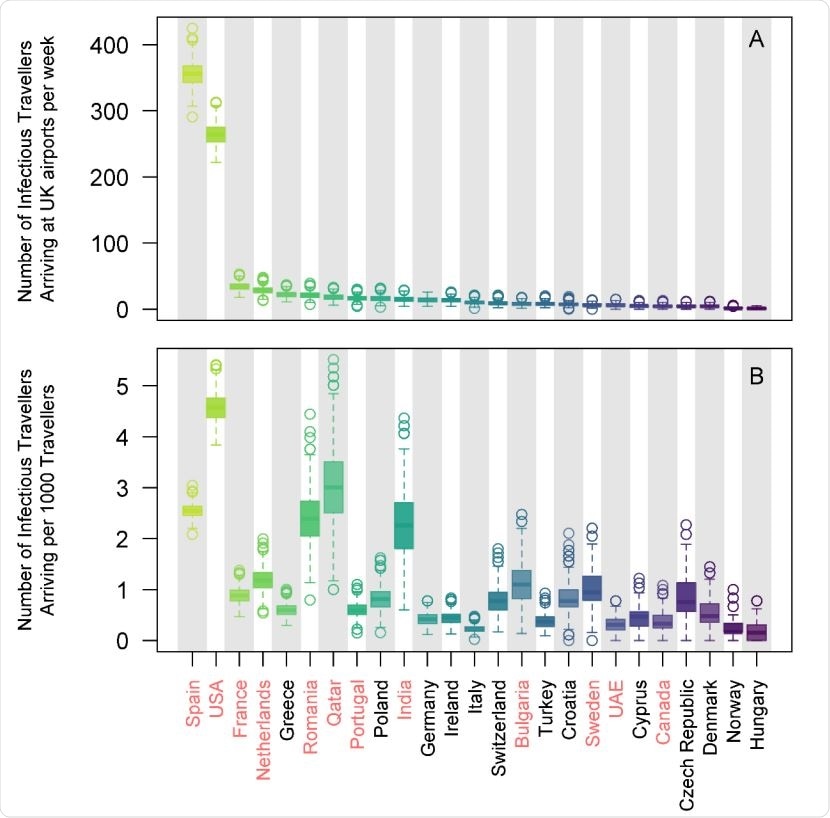Researchers have said that the UK guidance on preventing severe acute respiratory syndrome coronavirus 2 (SARS-CoV-2) from being imported via air travel does prevent a significant proportion of infectious travelers from putting people at risk of coronavirus disease 2019 (COVID-19).
The self-isolation measures required of twelve of the 25 countries flying the most people into the country do potentially stop 779 infectious travelers from transmitting the virus each week, say Rachel Taylor (APHA) and colleagues.
However, once the efficacy of self-isolation is also considered, hundreds of infectious individuals still enter the country every week, they warn.
The researchers also assessed potential alternatives to 14-day self-isolation that may be more feasible in the long term.
“Even fewer infectious travelers would bypass self-isolation by alternative strategies for quarantine,” they say. “Rapidly implementing control measures for travelers from risky countries is vital to protect public health.”
A pre-print version of the paper is available on the medRxiv* server, while the article undergoes peer review.

The expected number of SARS-CoV-2 infectious travelers (A), and number per 1,000 travelers (B), arriving into UK airports from each of the 25 countries in a single week in August without any UK health measures applied. Countries that require self-isolation on arrival to the UK on 17th August are indicated in red.
Understanding how to re-open international travel safely is essential
In the wake of the COVID-19 pandemic, international air travel was effectively brought to a halt. However, as the rate of infection cases declines in many countries, international travel is now being re-opened, and understanding how to do this safely and to which countries are essential.
“In particular, it is imperative to determine a risk-based entry strategy, and for that strategy to be flexible in order to react to changing disease prevalence worldwide quickly,” say Taylor and team.

The number of infectious travelers required to self-isolate (A), the total number of travelers required to self-isolate (B) and the BCR (C) for three different travel restriction strategies. The UK strategy is based upon the 12 countries within our 25 that require self-isolation on arrival. “Top 12 by Number” and “Top 12 by Rate” strategies are assuming the top 12 countries by number or rate (respectively) of infectious arrivals, as assessed in Figure 1, require self-isolation on arrival.
What did the current study find?
The researchers estimated the number of infectious travelers flying in from the 25 countries with the highest rates of flights into the UK. They used data on SARS-CoV-2 prevalence from 13th August in each of the 25 countries and in the UK. They also assessed the effectiveness of self-isolation requirements.
The team estimated that the number of infectious travelers arriving at UK airports from all 25 countries over the course of a week in August was 895.
The UK currently requires 14-day self-isolation for 12 of these 25 countries, but not for the other 13.
The 12 countries where self-isolation is required account for 779 of the 895 infectious arrivals, therefore potentially preventing 87% of infectious people from transmitting the virus, depending on the effectiveness of self-isolation.
However, the remaining 116 infectious travelers that are not required to self-isolate would not be prevented from passing the virus on.
Ranking the countries based on infectious travelers rather than rate of entry
Eight of the 12 countries where social isolation is required are among the top 12 countries, once the countries are ranked by the number of infectious travelers.
The authors say that if the travel restrictions were focused on the top 12 countries based on the number of infectious travelers, rather than the highest rate of people entering the country, 819 (91%) of all infectious arrivals would need to self-isolate.
This strategy would require an additional 76,334 travelers to self-isolate, which would be associated with a significantly lower benefit-to-cost ratio than a strategy based on the top 12 countries with the highest rate of entry.
Alternative measures to 14-day self-isolation
Next, the team compared alternative measures to the 14-day self-isolation policy (which is 78% effective) that may be more practicable in the long-term.
The researchers considered the use of health checks and thermal imaging scanners at the airport, SARS-CoV-2 testing by reverse transcriptase-polymerase chain reaction (RT-PCR) and self-isolation upon arrival for 7, 10, or 14 days.
The team reports that both thermal imaging and health checks were completely ineffective; airports that rely solely on thermal imaging scanners would only identify one of every 128 infectious individuals.
A single RT-PCR taken upon arrival at the airport would only detect 2 of every 5 infectious travelers (36% effective) while testing four days post-arrival would be 64.3%, and testing on arrival plus four days later would be 68.9% effective.
The double testing strategy is superior to self-isolation for 7 days, which was only 51.3% effective, whereas it would be comparable to self-isolation for 10 days (68.8% effective), but inferior to self-isolation for 14 days (78.0% effective).
Lengthy self-isolation is problematic
Delaying the RT-PCR testing for 7 days would be more effective, at 75.9%, but would require a more extended period of self-isolation.
“Lengthy self-isolation periods may also incur indirect costs due to lost workplace productivity and less social expenditure,” says the team.
The researchers say that eventually, a strategy other than the 14 days self-isolation will probably be needed for longer-term planning.
“It is important that public health officials act rapidly with the latest data estimates in order to control the risk from this fluctuating situation,” they write.
“This methodology can be quickly updated to assess the impact of any further changes to international travel policy or disease occurrence,” concludes the team.

 *Important notice: medRxiv publishes preliminary scientific reports that are not peer-reviewed and, therefore, should not be regarded as conclusive, guide clinical practice/health-related behavior, or treated as established information.
*Important notice: medRxiv publishes preliminary scientific reports that are not peer-reviewed and, therefore, should not be regarded as conclusive, guide clinical practice/health-related behavior, or treated as established information.